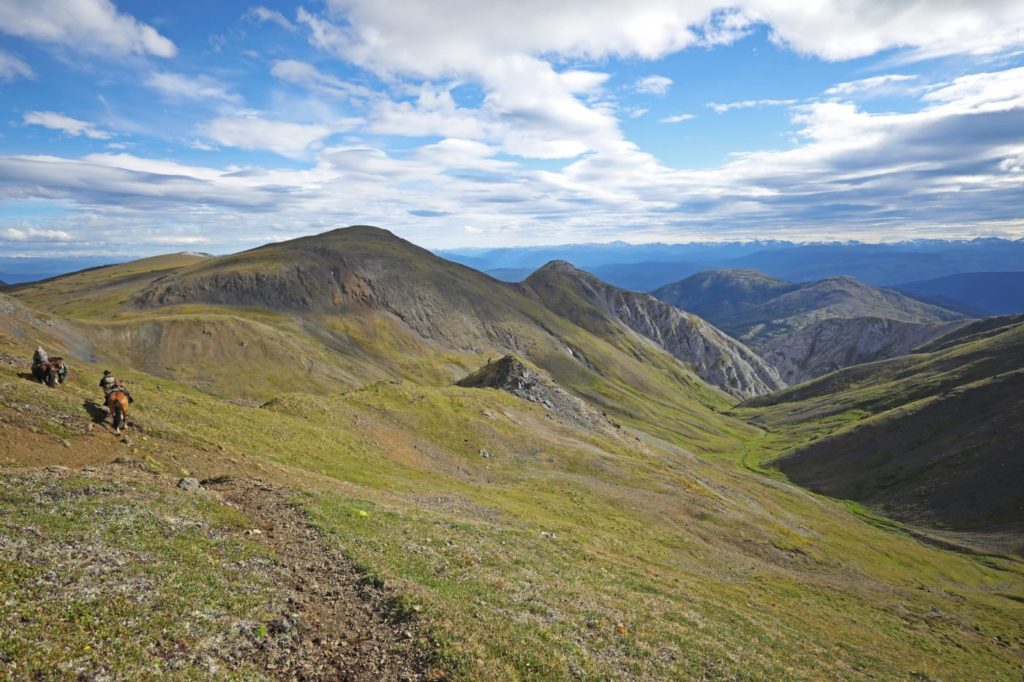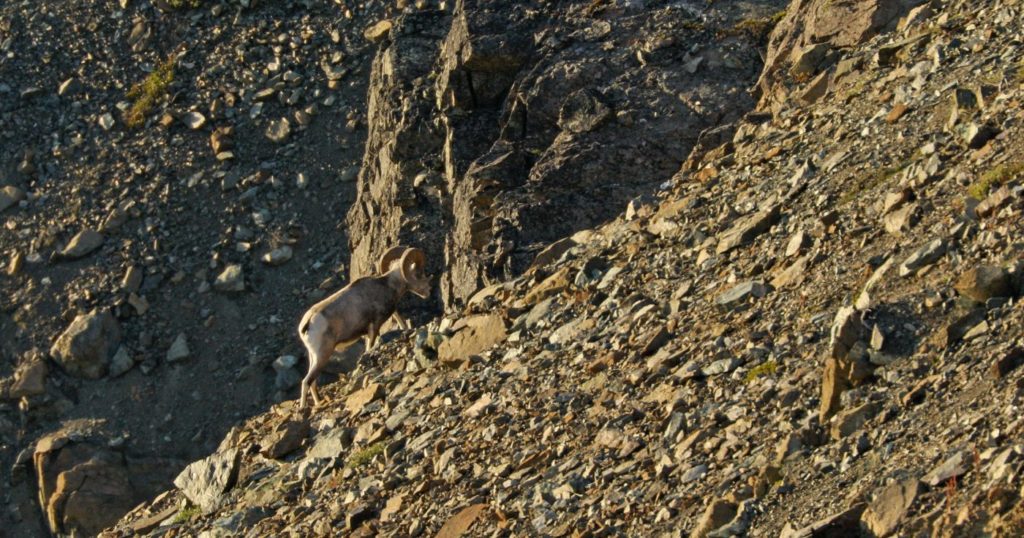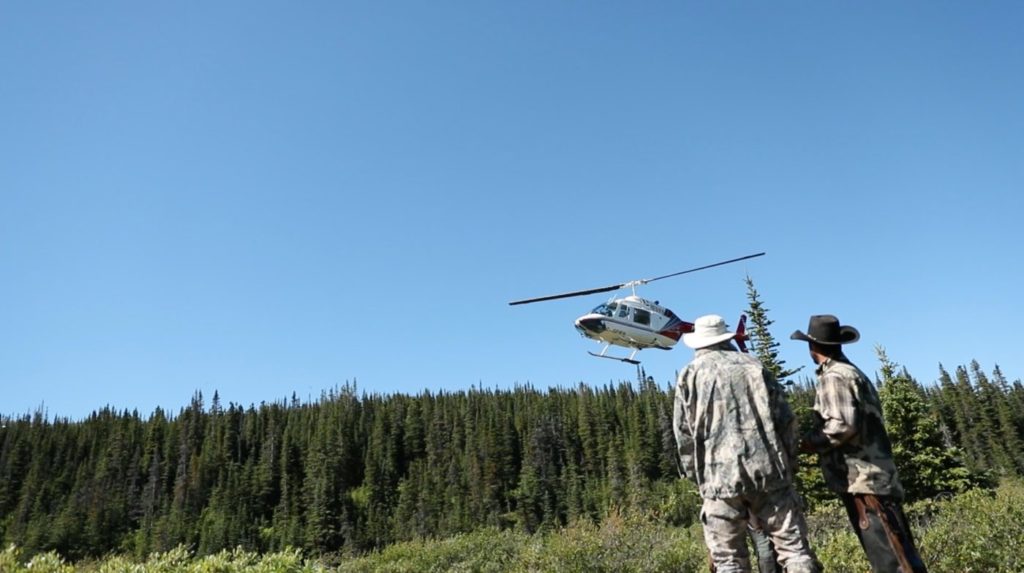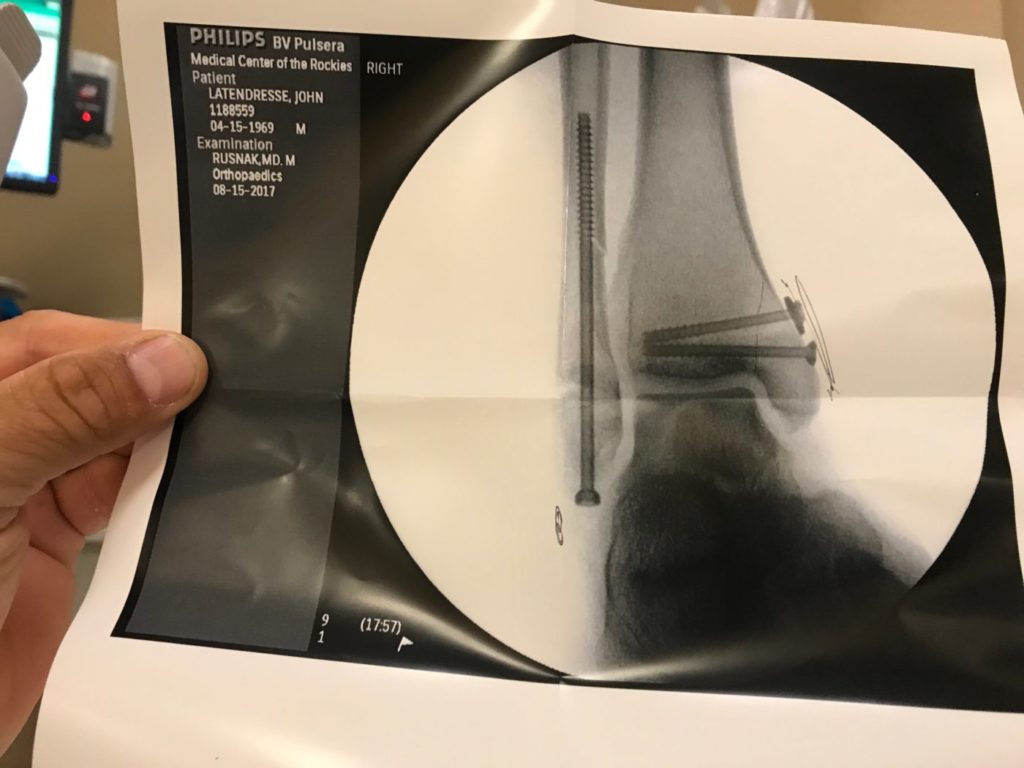All Photos Credit Latendresse Media
On the morning of August 8, 2017, we were wrapping up a Stone sheep hunt in Northern British Columbia. This was one of the most beautiful and classic wild sheep habitats I have ever seen. Lush green alpine meadows rolled across the high country, surrounded by natural rock cathedrals, towers of limestone, and granite peaks. While mature Stone sheep rams are one of the most elusive animals on the planet, we were blessed with sightings of more sheep than I could’ve imagined. In fact, we saw over a hundred sheep the first day—but no legal rams. We spent hours and days, hidden in the boulder fields, glassing over miles of uncharted territory. We looked in every nook and cranny, in every changing light condition; the difficulty of spotting bedded rams in the rocky peaks is indescribably difficult. But with the experienced eyes of the guides, we finally spotted a tremendous ram. He was with a half-dozen of his buddies and he stood out like a man among boys, with his sturdy girth and full-curl right side. Broomed on the left, he was easily identifiable, even from 1,500 yards.
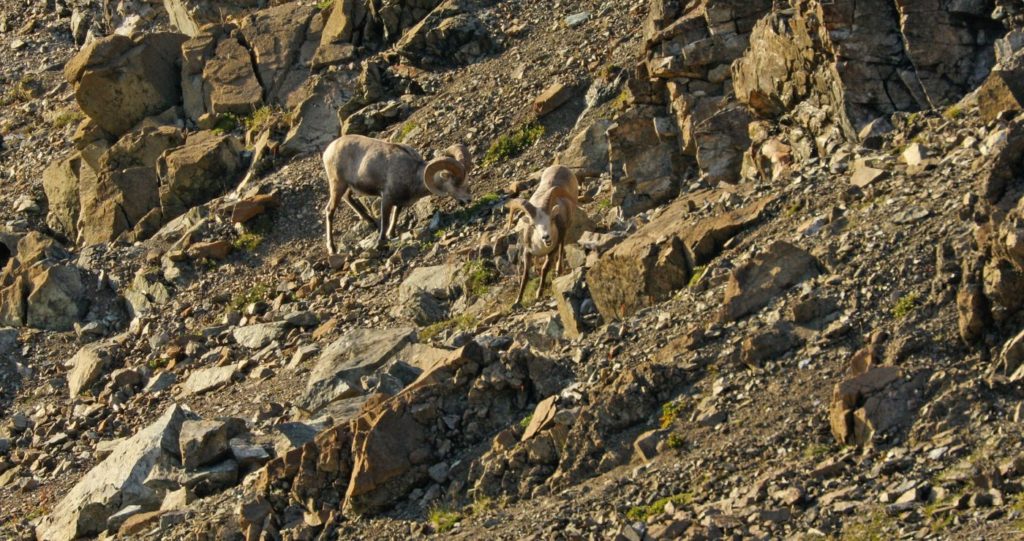
We sat on a flat, glassing him while he and his comrades bedded down on a protected ledge at the top of a jagged peak. No way to get to him. The only chance was to let them get restless and make the first move. We waited for hours, and finally the band of rams began to pick their way across the skyline, zigzagging in and out of scree slopes and rocky ledges. They finally went around the corner so we could quickly make our move so we jumped on the horse and slipped around the base of the mountain. We inched forward and glassed, so as to not to spook them or make them aware of our presence. Just like a mass of burning gas, they slipped into thin air and vanished. One thing about wild sheep: you’re rarely going to catch them from behind. But we had no choice except to try.
After three more days of searching for this particular ram, we simply had to face reality. He was gone—or at least we couldn’t find him. At camp on the fourth night, we sat around the fire eating a massive mound of spaghetti, listening to the guides sort out a new game plan. The next morning we went through the ritual of breakfast and coffee, saddled up, and began riding upward. We passed through a very Mongolia-like pass into the backside of the adjacent peaks. As we rose over the skyline of the pass, one of the most amazing sheep scenes I’ve ever encountered unfolded in front of me. It was heavenly; reverent and biblical. Small family flocks of sheep as far I could see. Young rams, ewes, lambs, and yes, even one band of nice-looking rams. There must have been over 40 sheep, right in front of us. It was like a movie scene.
We all hit the deck and began scouring the landscape with spotting scopes and binos. After a few hours of glassing, the disappointment became a reality: not a shooter ram in sight. It was also extremely hot and dry for this time of year, in the upper 80’s, so we began to think about actively searching out some shade to continue glassing, knowing the smart, mature rams had probably gone nocturnal to avoid the heat and mosquitos.
Did I mention the mosquitos? They were horrendous and completely impossible to control, and were heavily influencing the sheep’s behavior. So we went up and around to the shady side, then plopped down and spread out to glass in different directions to maximize our coverage. Again, after a few hours of searching, my good friend and guide Todagin Hodson turned to me, “I got one. A good one. Oh man, he’s got some mass and length. I think it’s the same ram from the other day, eh.”
My client and I both located the ram via Todagin’s direction, and sure enough, this was a gorgeous ram with a broomed left side and a full-curl, tipped-out right. We immediately ran over to the outfitter and suggested we had a legal ram in sight.
We wasted no time, as the evening sun was beginning to sag and the afternoon light was turning gold. We knew we had to cover some ground to close the distance, well over a mile away. We grabbed our gear and scurried off to the main ridge. Staying out of sight, we went up and down two big saddles, crossed a short knife-edge ridge, and finally made it to where we thought we could set up and wait the rams out.
It was still warm, so the guides suggested we hunker down in a little boulder field, get everything ready, and wait this out as the evening air cooled. The hunter made his bench, the guides got in position, I had my cameras all set up, and the wait was on. Finally, the head guide motioned forward. “There they are. Right there.”
Every man focused on the area and sure enough, our ram had done exactly what we wanted him to. He and a buddy came out on the rocky slope on our side of the deep cut and started feeding downhill and slightly toward us. Our goal was 350 yards, and as my hunter ranged the two rams, he whispered 220. The outfitter was quickly getting a solid age on the ram before we reacted in any way. He looked and looked and looked, then hissed to the head guide, “Why don’t you take a look at him.”
We passed the 75x Swarovski scope to him. He began counting the growth rings and judging whether the ram’s curl fully breached the bridge of the nose. It was incredibly close, because the lamb tip on the ram’s right side flared out instead of up to make it a half-inch too short, and all they could see were seven identifiable growth rings. In BC, a Stone must be eight years old OR his curl has to fully breach the bridge of the nose, without exception. Such strict wildlife management regulations are there to protect the animals and ensure the harvest of only mature rams.
As disappointing as it was, we all looked at each other; the outfitter leaned toward the hunter and said, “I’m sorry, Paul, but we can’t take any chances. We have to let him go. It’s too close.”
The head guide turned and looked at me, because I had this bewildered look on my face that screamed, “WTF?!” I’ve been on a dozen sheep hunts and knew that you typically get one or two opportunities, and we just had ours.
The guide looked at me and said with confidence, “Up here, an inch is a mile, man.” It was at that point I knew we had a long night ahead of us to get back to camp in the dark.
We returned to camp at 1:15 am. The hunter was getting tired, I could tell. He was 68 years old and game for any obstacle, but his legs started to slip. Being the trooper that he is, we went out two more days searching high and low, far and near, only to find more young rams. The clock was ticking, and Paul considered calling off the rest of the hunt so he could head back to base camp. He had a Dall sheep hunt and a bighorn hunt on the agenda over the next month, so he was pacing himself and wanted to be realistic about his energy levels.
That evening brought lots of contemplation in camp about what to do next. We finally decided to hit the sack and make a quick decision after some much-needed sleep. As the morning sun rose above the ridge top, we began to rustle around, one by one. After some breakfast, Paul made the decision to pack up and head out.
Packing up a sheep camp isn’t a simple task. We had personal belongings to pack and we had to balance all the pantry boxes evenly before they were mounted onto the pack horses. We finally got ready to roll out around 9:00 am, and that was when the fastest and most aggressive ten seconds of my life flashed in front of me.
After we saddled up, we rode the horses across a mountain stream onto a small dirt flat on the dry riverbed. We staged there while the wranglers untied each pack horse so they’d be free to follow us on the trail; standard procedure. Then one of the horses tripped in the stream, which made another horse nervous; the sounds got louder and the saddle horses began to become uneasy as well. The horses all came across at one time and as luck would have it, one of the pack horses hit something with a hard pantry box behind me, startling my horse into bucking and kicking. I held on, aware of what was happening, and pulled on the right rein in an attempt to keep my horse close to me. I tried to ride it out, but I think my horse felt trapped and reared up on her back legs, flipping all the way over on top of me.
Unfortunately, my right leg was her landing pad. Everything happened so quickly, but as I recall, I hit on my back first, as the horse came down on her rump. My backpack saved my head and spine from hitting the ground, so I was sort of sitting up when Ellie Mae’s body hit the dirt. I remember seeing her come down on my leg, and all I heard was a loud crunch, like a bag of Doritos getting squashed. CRRRUUUNNNCCCHHH. My first words were, “F–K, MY LEG! I BROKE MY LEG!”
Ellie Mae rolled over to her left, got up, and ran away. At that point, I had already started looking up for my buddies. Within seconds I had two guys standing over me, who helped me roll over onto my knees, and another guy had already started calling for emergency help. The pain still hadn’t set in, so I was laying there on my knees in the prayer position with my head in the dirt.
All I could think about were my wife and kids, and I hopes as hard as I could that it was a sprain and nothing more. A deep throbbing began to set in, so I decided I wanted to take one deep breath and try to put weight on my legs. Still strapped into my boots, the guys helped me up. I forced them to let me try this, and with the slightest pressure on my foot, white-out flashed over my eyes and an electrical impulse like a taser went through my body. Maybe I’m a wuss, but pain like I’ve never felt before shocked my body and I immediately hit the ground. We all knew it was time to sit and wait for Global Rescue to arrive.
My friends used their satellite phones to reach base camp, who then called Global Rescue, and 3.5 hours later, I was riding out in a helicopter. All I can remember is how helpful my buddies were, how quickly they reacted, and how they carried me to the chopper for take-off.
As I stared out the window of the chopper, watching the mountains, trees, and lakes pass under us, I had to wonder about the future. The care that was I going to receive and how the hell I was going to get home to my family.
An hour later we landed on a pad at Dease Lake, British Columbia; a very small community on a First Nation native reservation. There was a health clinic there, with an emergency room. They wheeled me into the ER, carefully removed my gaiter and boot, and shot me with Demerol for the excruciating pain. Naturally, I grabbed my cell phone, searched for Wi-Fi, and in a dizzy, drowsy haze called my older sister, Gina. I told her what had happened and then I decided to text some of my friends, to get the news to them. I didn’t know how to tell my wife nor did I want to cause her to worry about me before I even knew what to tell her. We have two beautiful little children, Aspen (5) and Walker (3), and I knew Laura had too much to deal with without worrying about my situation and state of health. So I decided to wait.
Let me add something about the health center at Dease Lake. To my surprise, I was treated with unbelievably good medical care. The doctor on duty was a bright South African with an extremely high level of concern and calming demeanor. They took care of me like family. Needless to say my impression of them was too heartfelt to describe on paper. They built a cast for my leg, gave me some pain management drugs and instructions, and sent me to the local hotel—my only option—since the ER did not have overnight facilities.
I required a follow up the next morning before we made plans to get to Whitehorse, Yukon; the closest airport. After a quick follow-up and some paper work, my friend Todagin and client Paul made room for me to lie down in the back seat of the pickup and we headed for Whitehorse. I was in and out of sleep during the eight-hour drive up the Alaskan Highway. I actually don’t remember a lot of it, having been severely sedated with painkillers.
After a bumpy ride we reached town, during the busiest part of the tourist season; we couldn’t find any vacancies in town. I had to settle for a solo room at the Casa Loma motel ten miles away, which was reminiscent of the hotel scene in Natural Born Killers. I didn’t mind. I just wanted a bed, a roof over my head, and a connection with Global Rescue.
Once I settled into my bed, I elevated my leg and started communicating again. I texted my friends again to let them know I was safe and ready for the next phase to get home. I also decided to call my wife to tell her what was going on. As usual, she stayed calm and collected; she’s a very balanced woman. I then got a call from one of the Senior Medical Operations Directors at Global Rescue. While all this other stuff was going on, they were busy trying to get me flights booked for a return to the United States and they were in the process of booking flights for one of their staff medic escorts to come get me and bring me home. Unfortunately, all the flights were full until Friday, so I was stuck in the Casa Loma for a few days.
During that time I fell down on my leg, had to call an ambulance, drank a half-liter of Fireball, watched two preseason football games, slept, and drank as much water as I could. Sweating and aching, I was desperately looking for food and a new hotel by 9:30 am Thursday. Nothing was open for food delivery, but I did manage to get a vacant no-show room at the Days Inn in Whitehorse and it happened to be on the ground level, so things were looking up.
My client called me a cab, driven by a friendly little guy who went far beyond his call of duty to help me. He and Paul hauled all my heavy gear down to the van and took me straight to my new hotel. After getting some food, water, and a nice room with air conditioning, I was contacted by Global Rescue again. They now had a plan, and it was a good one. They informed me that they had taken care of all the evacuation expenses, had bought me a new plane ticket home, and a medic was on his way from San Francisco where he was staged on his way back from another extraction in New Zealand. Yep, this medic, Mark Zamora, had just returned to the states from helping an injured USA Ski Team member get home before he caught a plane straight to the Yukon to help me. Selfless and fully sacrificing his time and energy for me was remarkable, and I will forever be grateful. He helped me all the way home and into my house before catching an Uber ride back to Denver for his flight home to New Hampshire, at midnight.
Whew. Finally home. I am writing this on Tuesday, August 15, 2017, at 10:37 am. I have a broken tibia, fibula, medial malleolus, and lateral malleolus. I had a surgical evaluation yesterday that showed a need for three screws and possibly a titanium plate on my tibia. And for all that, I feel fortunate and very grateful to be in the position that I am. This could’ve been far worse and much harder on me, or worse yet, my family.
My surgery is scheduled for 3:00 pm today, so I’m anxiously awaiting that ride to the Orthopedic Center of the Rockies, one of the best orthopedic centers in the country, and ironically, 20 minutes from my house.
I cannot begin to thank everyone for all the support. From phone calls, text messages, and emails, to social media posts from around the world. It’s hard on a guy trying to be tough through all this, but when family, friends and people that I don’t even know reach out the way they have, it’s overwhelming and emotional. People like John LoMonaco and Bobby Martin were calling me suggesting that they either send a plane up or come get me themselves. Gray Thornton, the CEO of the Wild Sheep Foundation, offered unconditional help as well. Who does that? It’s a large piece of humble pie that’s very hard to swallow. But very much appreciated.
I also cannot thank the staff and personnel from Global Rescue enough. Their professionalism and ability to execute a plan that got me home to my family and the care I needed was top-notch. Having now personally experienced one of those “it will never happen to me” events, I cannot more strongly recommend Global Rescue to the adventurous hunter or traveler.



